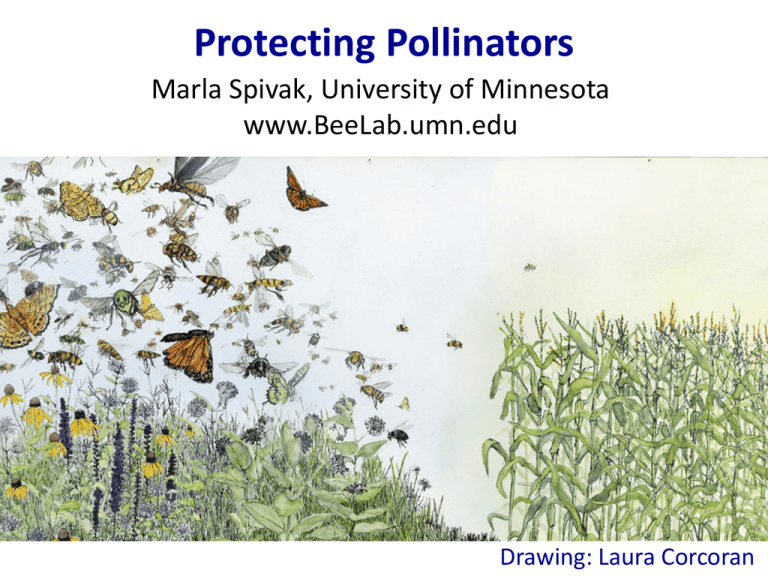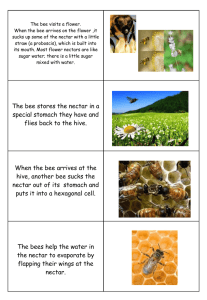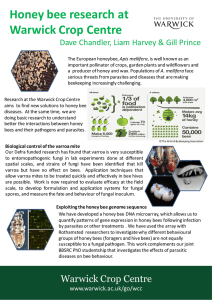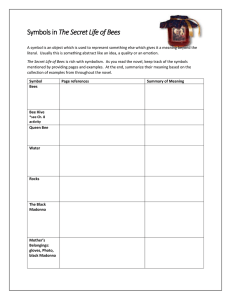Protecting Our Pollinators - Minnesota Landscape Arboretum
advertisement

Protecting Pollinators Marla Spivak, University of Minnesota www.BeeLab.umn.edu Drawing: Laura Corcoran Multiple, Interacting Causes of Death Varroa Parasite Viruses Insecticides Nutrition Pest and Pathogen transmission Other Pesticides Flowerless landscape Varroa Parasite Viruses Insecticides Nutrition Pest and Pathogen transmission Herbicides Flowerless landscape Herd Immunity Herd Immunity For Bees If only some colonies are treated for Varroa… If most get treated… ….varroa and viruses spread … spreading is contained Beekeepers need new ways to control Varroa The mites have gained the upper hand Multiple, Interacting Causes of Death Varroa Parasite Viruses Insecticides Nutrition Pest and Pathogen transmission Other Pesticides Flowerless landscape Honey bees, wild bees and other pollinators reduced to feeding on scraps - Z. Browning Commercial beekeeper, ND Laura Corcoran Insecticide Use Organophosphates Carbamates Organochlorines Neonicotinoids Pyrethroids Insect Growth Regulators Good, clean bee food Bee Nutrition Pollen provides protein and lipids Honey bee and Bumblebee on Dalea Photos: Heather Holm Bee Nutrition Nectar provides carbohydrates…and more Colletes on Allium Photo: Heather Holm Ceratina Melissodes Photos: Heather Holm Agapostemon Anthophora Photos: Heather Holm Butterflies sip nectar through long proboscis Or lay eggs on plant proboscis Many flies sip nectar from flowers Flower flies are bee mimics! What flowers should you plant for pollinators? • Take a long, close look at flowers. • If bees, flies or butterflies are drinking nectar, or collecting pollen from them, they are good! • Write down exact variety of the flower Honey bees Nectar - Honey Pollen Honey • p-coumaric acid • pinocembrin • pinobanksin Originate in pollen and propolis Bees Can Detoxify Pesticides to some extent… P-coumaric acid turns on detox genes, which make P450 enzymes, which metabolize pesticides P450 Soil Nesters Andrena on plum Photos: Heather Holm Dennis Briggs Honey Bees Vitellogenin Vg Brood food Honey Bee Solitary Bee Larva We need foraging areas for bees to detox! Drawing: Laura Corcoran Areas to Detox in Town: Flowering Bee Lawns • Reduce intensive inputs – water, fertilizer, mowing • Support bee health Research Ian Lane Funded by MN Environment and Natural Resources Trust Fund How does agricultural land use affect survival of honey bee colonies? Dr. Matthew Smart Research Funded USDA-NIFA Study colony locations Month Location May Jun Jul Aug Sep Oct Nov Dec Jan Feb Mar CA holding yards CA almonds ID holding yards ND apiaries 144 colonies in 6 apiaries sampled and assessed every six weeks in ND and CA. Apr The landscapes: 6 apiaries from 2010-2012 When Varroa and diseases not a factor, floral resources within 2 mi of apiary has significant effect on health and survival of colonies • Brood in Sept • Mite load in Sept • Grams pollen/ per day over summer • Vitellogenin • Lipid Stores • Immune System Activation Colony Pesticide exposure Pollen hazard quotient (PHQ): Mean ppb of each pesticide/ honey bee contact LD50 Bee Toxicity High, ≤2 μg/bee Moderate, 2-11 μg/bee Low, >11 μg/ bee No neonics detected New Bee and Pollinator Research Lab UMN St. Paul Campus Groundbreaking August 3 Save the Date! Univ MN Welcomes Dr. Dan Cariveau Pollinator Ecologist Native Bees and Habitat New Pollinator Discovery Center Univ MN Landscape Arboretum Goundbreaking this August MSR Architects Big Thanks to Graduate Students! Mike Wilson Katie Lee Elaine Evans Joel Gardner Ian Lane Judy Wu- Smart Renata Borba Matthew Smart Mike Goblirsch Morgan Carr-Markell Becky Masterman Jessica Helgen Jenny Warner Clara Costello Keith Johnson Bridget Mendel Dan Case Julie Tomaska Anne Turnham Ana Heck Mike Lamb Judy Griesedieck Thank you Bees, Beekeepers & Supporters National Science Foundation USDA-NIFA NRCS National Honey Board Almond Board General Mills MN Environmental and Natural Resources Trust Fund Minnesota and North Dakota Beekeeping Associations Individual donors www.BeeLab.umn.edu




